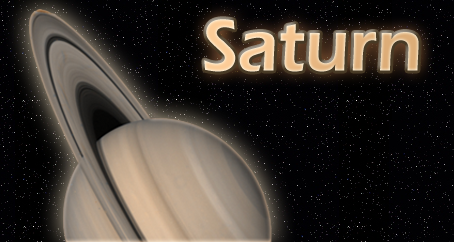Titan, a moon of Saturn
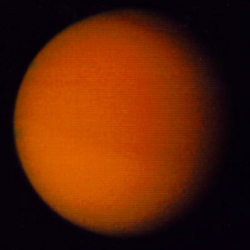
Titan is a moon of Saturn. It was discovered in 1655 by Dutch astronomer Christiaan Huygens but didn’t receive its current name until 1847. Titan is Saturn’s largest moon and is the second largest moon in the solar system. Ganymede, a moon of Jupiter, is the largest. Titan is unique as being the only moon in the solar system with a thick atmosphere. Titan was recently visited by a space probe which landed on its surface and sent back images. Titan is of particular interest to scientists as it is believed that it may share some similarities to an early Earth.
Titan’s Discovery and Name

As Saturn’s largest moon, Titan is the easiest to see around the planet and was the first to be discovered. The Dutch astronomer Christiaan Huygens (pictured right) was the first person to spot it on 25th March 1655. He used a home-made telescope that he had built with his brother Constantijn. Back then, telescopes were a fairly new invention. Italian astronomer Galileo Galilei was one of the first astronomers to use a telescope and he was the first person to find moons in orbit of a planet other than Earth, discovering the four large moons of Jupiter (Io, Europa, Ganymede and Callisto). As no other moon was known to exist around Saturn at the time, Huygens referred to his new discovery as Saturn’s Moon, or Saturni Luna as it was fashionable at the time for scientific folk to give things Latin names.
As more moons came to be discovered in orbit of Saturn, they were given a number based on their position in orbit of the planet: Saturn I, Saturn II, Saturn III, Saturn IV, etc... This method would later turn out to be impractical as moons began to get discovered in between moons that had already been given a number so existing moons had to be renumbered, but it wasn’t until 1847 when English astronomer, John Herschel, came up with the ingenious idea of giving names to the moons of Saturn. As Saturn (Cronos in Greek), which had had its name for a long long time, was the leader of the Titans in mythology, Herschel proposed naming the moons of Saturn after mythological Titans and Giants. The moon discovered by Christiaan Huygens would be named Titan. And the name has stuck since then.
Titan's Vital Statistics
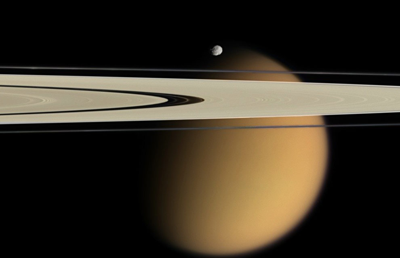
Titan is the second largest moon in the solar system. Its diameter (width across the equator) is 5,150 kilometres (3,200 miles) making it larger than objects such as the planet Mercury (4,878 kilometres / 3,031 miles), dwarf planet Pluto (2,390 kilometres / 1,430 miles) and Earth’s Moon (3,475 kilometres / 2,159 miles). The only moon larger than Titan is Ganymede, a moon of Jupiter which is 5,262 kilometres wide (3,270 miles). However, Titan’s thick atmosphere makes it appear larger than Ganymede, which doesn’t have an atmosphere. Titan takes just under 16 days to orbit Saturn and 16 days to spin on its axis. This is because it is stuck in what is known as a “synchronous rotation” - basically meaning that the same side of it always faces Saturn. The exact same thing happens with the Moon orbiting Earth. Titan orbits Saturn at an average distance of 1,221,830 kilometres (759,208 miles). It’s a very chilly place with a temperature of about -180 °C (-292 °F). Despite being this temperature, Titan isn’t as cold as it could be. Titan’s thick atmosphere creates a Greenhouse Effect on the moon. Although it doesn’t receive much heat from the Sun, the heat that it does receive isn’t able to escape through the atmosphere as it is so thick. However, the thick atmosphere also prevents other forms of energy from the Sun from reaching its surface, such as light. This means that, if you were able to stand on Titan’s surface, it would be quite dark.
Another Earth?
Titan is a moon which shares a number of similarities to Earth, even to the point that some scientists believe it could support some kind of life! Titan is the only moon in the solar system with a thick atmosphere. Atmosphere is the name given to the layer of gasses that cling on to an object. You might know it as sky! The gasses in an atmosphere vary from object to object. Earth’s atmosphere contains mostly nitrogen with a smaller amount of oxygen (essential for human life). The atmospheres of Mars and Venus contain mostly carbon dioxide, a poisonous gas. Titan has a very thick atmosphere - Earth’s atmosphere is actually quite thin. It is said that because Titan’s atmosphere is so thick and its gravity so weak that, if the moon could support human life, it would be possible for humans to fly in its sky! More exciting are the contents of Titan’s atmosphere. Like Earth, its atmosphere is mostly made of nitrogen. In fact, Titan is the only place other than Earth to have a nitrogen-rich atmosphere!
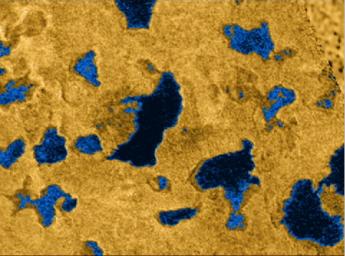
Titan’s surface also shares similarities to Earth. It appears to have had a volcanic history, has hilly areas and smooth areas. It even has lakes, rivers and seas. However, taking the place of water on Titan is methane and ethane. The moon’s lakes are full of liquid methane, while its skies contain methane particles and cold regions are made of methane ice. It is even believed that methane rains on the moon, although the weak gravity would cause it to have the strange effect of it slowly floating to the surface.
Methane is a chemical element that is used on Earth as a natural gas. It is not poisonous, but it is flammable. It doesn’t actually have a smell (the smell of gas is added to methane to warn you of its presence). As it is naturally present and isn’t really harmful, scientists are interested in the fact that Titan has the element in abundance in combination with a nitrogen-rich atmosphere. They believe that lifeforms on Titan could have evolved to use methane in the way that lifeforms on Earth use water, and can survive in much cooler temperatures than those on Earth. One thing for certain is that lifeforms from Earth simply wouldn’t survive on Titan.
There are also theories that there is subsurface water on Titan, which could enhance the chances of life existing, either now, in the past, or even in the future. Titan is seen as a possible candidate for future life, even if it doesn’t yet exist, and that its current state is similar to what Earth may have been like in its very early years. In the distant future, the Sun will expand and heat up as it naturally gets older. It could possibly get so large that it will absorb the Inner Planets. Mercury, Venus, Earth and Mars will simply not exist. Even if they did, they would be so hot that they wouldn’t be able to support any form of life. However, a moon like Titan could benefit. The Sun’s extra heat would warm Titan and make it more suitable for life. Could it also unlock any water present deep below its surface?
Exploring Titan
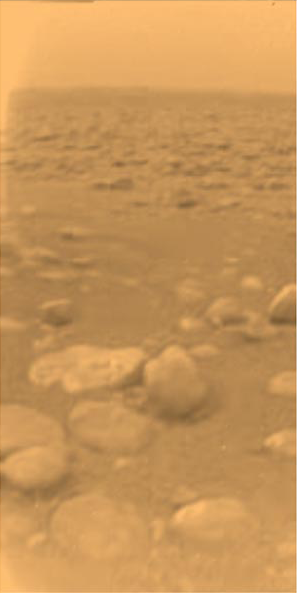
As one of the more unique moons in the solar system, it is of particular interest for exploration. It has been imaged by a number of space crafts. The Pioneer and Voyager probes of the 1970s and 1980s sent back images of a featureless world, but with interesting chemical properties. But, in 1997, the Cassini-Huygens space craft was launched to explore Saturn and its moons. The space craft consists of two parts: the Cassini probe, which is an orbiter and is still active, and the Huygens probe, which was an atmospheric entry probe designed to enter the atmosphere of Titan and land on its surface.
While in orbit of Saturn, Cassini has used radar and infrared technology to see through Titan’s atmosphere and reveal information about the moon’s surface. It has observed the lakes of liquid methane and found evidence of subsurface water. These observations are the first (and so far only) of a body of liquid on any world other than Earth. The Huygens probe, named after the man who discovered the moon, had a much closer encounter with Titan. It was released from Cassini in December 2004 and landed on Titan in 14th January 2005. During its descent and for a few hours after landing, Huygens sent back data and images of Titan. The first image to be sent back from the surface of Titan is to the right. Although it was designed to operate if it landed in liquid, it appears to have landed in a dry area, surrounded by pebble-like rocks. The presence of pebbles suggests that they have been smoothed by liquid, and an image taken from the surface shows that Titan is an orange, hazy world. Incidentally, Huygens is the only space craft to have landed on the surface of a moon other than Earth’s own moon, and is the most distant man-made object to rest on the surface of another world. It was also the first space craft to have a microphone and recorded and sent back sounds from another world. Some of these sounds can be heard here.
Another mission is planned to continue what the Huygens probe started. The Titan Saturn System Mission (TSSM) will travel to Saturn but with Titan as its main subject. This mission will be a little different to traditional space missions. It will still be an orbiter, like Cassini, but will release two probes to descend to Titan. One of these will take the form of a hot air balloon, which will travel around the moon about 10 kilometres from its surface. The second probe will be a lake lander, splashing down in one of Titan’s bodies of liquid methane to analyse the lake’s properties and try to find out what, if anything, lurks beneath.
One thing for certain is that Titan is quickly becoming one of the more interesting and unusual worlds in the solar system, yet is somehow very familiar.
